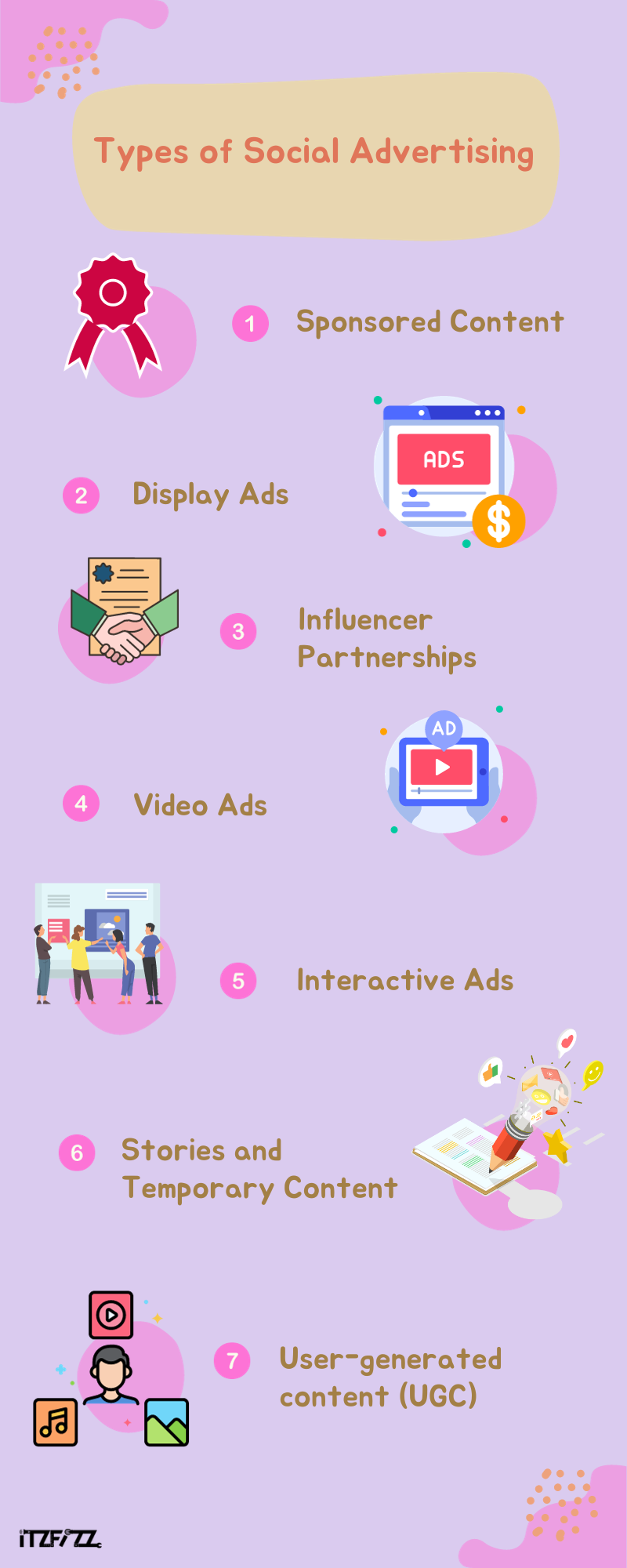Table of Contents
- Introduction to Social advertising
- The target audience for social advertising
- Types of social advertising
- Strategies for social advertising
- Perks of Social advertising
- Social media marketing vs organic posts
- Conversion rates for social advertising
- Campaign goals for social marketing campaigns using social media
- Conclusion
- Frequently Asked Questions
Introduction to Social Advertising
A fundamental component of modern marketing is social advertising, which involves the purposeful promotion of products, services, or concepts on social media platforms. It goes beyond simple distribution; it entails building connections and interacting with a specific audience in their active digital venues.
The expansion of social platforms and the progress of social media advertising are complementary. From straightforward banner ads to the complex targeting and personalisation of today, it shows a deep comprehension of online customer behaviour and the value of forging deep connections.
Social media sites like Facebook, Instagram, Twitter, and LinkedIn offer a variety of advertising options catered to specific target populations. Understanding the subtleties of each platform from LinkedIn’s professional networking to Instagram’s visually stimulating posts is essential for campaigns to be successful.
Social advertising is unique because it plays two roles: it builds relationships with its audience in addition to selling goods and services. Brands may create a feeling of community that goes beyond typical marketing limits by fostering committed followings through interactive ads, direct communication methods, and intriguing content.
We’ll examine social advertising’s varieties, approaches, and benefits in this investigation. We’ll break down how it differs from natural social media marketing and show you how it may be a flexible tool to accomplish campaign goals.
The Target Audience for Social Advertising
For social media advertising to be effective, it is essential to identify and comprehend the target demographic. The first step is known as demographic segmentation, and it includes variables like age, gender, location, income, and education. Different platforms draw different types of users; for example, Instagram appeals to younger, visually oriented users whereas LinkedIn is more appropriate for professionals.
Psychographic profiling goes beyond demographics to explore the interests, attitudes, and behaviours of the target audience to produce advertisements that elicit strong feelings. When creating content that has an impact, behavioural insights gained from user engagement patterns and content exchanges are essential.
Brands may understand audience mood, language nuances, and current trends by employing social listening techniques. This useful data makes it easier to create interesting and relevant content. After identifying the target demographic, the next step is to customise social media advertising material to appeal to their requirements and tastes.
This strategy not only makes sure the audience sees it, but it also connects with them, increasing engagement and conversion rates. A deep comprehension of the audience and the strategic matching of content to their interests and behaviours are essential for successful social media advertising.
Types of Social Advertising

Social advertising encompasses a variety of formats, each with its unique strengths and applications. Understanding these types can help advertisers choose the most effective approach for their campaign objectives.
- Sponsored Content: Sponsored Content appears directly in the user’s social media feed, resembling regular posts but with a “sponsored” label. This format is effective for storytelling and building brand awareness. It seamlessly integrates into the user experience, providing high engagement potential.
- Display Ads: Display Ads are more traditional forms of advertising that appear on the sides or headers of social media platforms. They are less invasive and can be effective for retargeting campaigns, reminding users of products or services they have previously shown interest in.
- Influencer Partnerships: Influencer Partnerships involve collaborating with social media influencers to promote products or services. These partnerships leverage the influencer’s credibility and follower base to reach a broader audience more authentically and engagingly.
- Video Ads: Video Ads are increasingly popular, especially on platforms like YouTube, Instagram, and TikTok. They can range from short clips to longer, more narrative-driven content. Video ads are highly engaging and can convey a message more dynamic than static images.
- Carousel Ads: it allows multiple images or videos in a single ad, each with its link. This format is great for showcasing different features of a product, telling a brand story, or explaining a process step-by-step.
- Interactive Ads: it encourages user interaction, such as polls, quizzes, or swipeable content. These ads are not only engaging but also provide valuable feedback and insights about the audience.
- Stories and Temporary Content: popular on Instagram and Snapchat, are ephemeral, creating a sense of urgency and exclusivity. They are ideal for time-limited offers, behind-the-scenes looks, or quick updates.
- User-generated content (UGC): involves encouraging users to create content related to the brand. This type of advertising fosters community engagement and provides authentic testimonials about the brand.
Strategies for Social Advertising
To maximise the impact of social advertising, it’s essential to employ effective strategies. These strategies should align with your overall marketing goals, target audience preferences, and the unique features of each social media platform.
- Establish Clear Objectives: To inform your decisions on the platform, structure, and messaging for the social media advertising campaign, clearly state your objectives. These can include increasing website traffic, generating leads, boosting sales, or building brand awareness.
- Audience Targeting and Segmentation: Make use of platform features to divide up your audience into groups according to their interests, behaviours, and demographics. This will help you create compelling advertising that increases interaction and conversion rates.
- Creative and Engaging Content: Provide aesthetically pleasing and captivating content that is in line with your brand voice, appealing to the requirements and interests of your audience, and utilising strong images, convincing writing, and obvious calls to action.
- Make Use of A/B Testing: Improve campaigns by using A/B testing. By playing with various components including headlines, pictures, and CTAs, you may adjust methods according to the audience response.
- Leverage User-Generated material: Use customer experiences as social proof, which has a big impact on purchasing decisions, to harness the power of user-generated material to develop trust and authenticity.
- Analyse and Monitor Results: Using analytics tools, regularly monitor campaign metrics like reach, engagement, click-through rates, and conversions to help you make wise decisions and improve your tactics.
- Keep Up with Platform Trends: In a constantly changing social media environment, stay ahead of the game by being informed about the newest platform trends and algorithm changes. This will help your campaigns continue to be successful.
Perks of Social Advertising

- Vast User Base and Targeting Capabilities: Social media advertising reaches billions of users worldwide, providing unmatched reach, and combines it with sophisticated targeting capabilities to accurately target the intended audience.
- Cost-Effective Marketing: Social media advertising, which is well-known for being reasonably priced, offers more budgeting alternatives than traditional media and real-time campaign changes that maximise spending efficiency.
- Improved User Interaction and Brand Awareness: Through likes, comments, and shares, users can interact with brands on social media platforms, increasing their exposure, awareness, and loyalty.
- Measurable Results: The main benefit of social media advertising is that it produces quantifiable outcomes. Real-time insights into campaign performance can be gained from detailed analytics, which include clicks, impressions, engagement rates, and conversion rates.
- Fast Feedback and Adaptability: Social media’s immediate feedback feature helps firms to quickly assess ad reactions, allowing for quick campaign adjustments,a crucial feature in a world where customer preferences are always shifting.
6. Integration with Other Marketing Channels: Social media advertising combines easily with a variety of marketing channels, including SEO, email marketing, and content writing, to produce a cohesive and all-encompassing marketing plan.
Social Media Marketing vs Organic Posts
An effective digital marketing plan requires an understanding of the differences between sponsored advertising and organic posts on social media. With scalable and quantifiable results, social media marketing uses sponsored advertisements to target particular demographics. However, unpaid promotion-free organic articles develop relationships, encourage real participation, and support long-term branding.
Both methods are used in a harmonic plan. Paid advertising reinforces particular messaging, while organic posts sustain consistent brand presence and interaction. To ensure a cohesive brand identity, the brand message must be consistent throughout both domains.
Paid advertising strategies are informed by data derived from organic engagement, resulting in a mutually beneficial partnership. Businesses can create a dynamic and diverse strategy for social media marketing, optimising audience reach, by identifying each platform’s advantages and skillfully combining them.
Businesses may maximise the effect and ensure a high return on investment by focusing on these principles and optimising their social media campaigns.
Conversion Rates for Social Advertising
In the world of social advertising, conversion rates are crucial to comprehend and optimise since they are a vital indicator of campaign effectiveness and return on investment (ROI). Conversion rate: a percentage that indicates how well advertisements encourage desired activities (downloads, sign-ups, or sales, for example).
To monitor conversion rates efficiently, set specific conversion objectives, make use of the analytics tools that social media sites offer, and include UTM parameters in ad URLs for comprehensive campaign tracking. Conversion rates are influenced by several variables, such as the relevancy of the advertisement, precise audience targeting, a seamless user experience, and effective calls to action.
Using techniques like audience segmentation for tailored messages, A/B testing of ad elements, landing page optimisation for relevancy, and constant monitoring with timely modifications are all part of optimising conversion rates.
Understanding and optimising conversion rates is essential in the realm of social advertising, as they serve as a critical gauge of campaign efficacy and return on investment (ROI).
Campaign Goals for Social Advertising Campaigns Using Social Media
The key to any effective social advertising effort is having well-defined objectives. These objectives should follow the SMART criteria (specific, measurable, attainable, relevant, and time-bound), which also govern strategy, content production, targeting, and assessment.
Objectives such as acquiring 1,000 new followers in a month or seeing a 20% increase in organic traffic within three months, for example, offer precise standards for success.
In social advertising, several campaign objectives aim to improve Sales and Conversions, Lead Generation, Engagement, Brand Awareness, and Customer Retention. It is imperative to align these objectives with the appropriate content and platforms. TikTok and Instagram are good choices for engagement because they demand interactive and sharing content.
Using Google analytics tools to track progress, strategically prepare material to fit goals, customise campaigns to the target audience’s preferences, and be open to modifying strategies in response to performance data and feedback are all part of the implementation. This iterative procedure guarantees that campaigns continue to be responsive, dynamic, and ultimately successful in accomplishing their stated goals.
Conclusion
An interactive bridge to connect with a variety of potential customers, social advertising is a cornerstone of internet marketing. This investigation explored its subtleties and emphasised critical elements for successful advertising.
When creating successful campaigns, it is essential to understand your audience. Various forms of advertising, such as interactive commercials and sponsored content, provide innovative interaction. Campaign performance is improved by strategic methods like A/B testing and well-defined goal-setting. Measurable impact provides data-driven decision-making for marketers. An improved overall social media presence results from the convergence of paid and organic initiatives.
Advertising tactics will change along with social media. Future developments will shape the environment, along with new platform features and evolving user behaviours. To fully realise the promise of social advertising, quick thinking and intelligent decision-making are essential.
Frequently Asked Questions (FAQ) :
How does social advertising work?
Why is social advertising important?
How effective is social advertising?
How expensive is it to run social media ads?
Budgets can be customised based on daily or lifetime spending. While costs vary, social media advertising is often considered cost-effective compared to traditional advertising, offering businesses flexibility in budget allocation.










